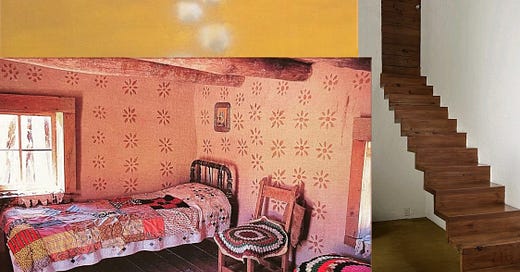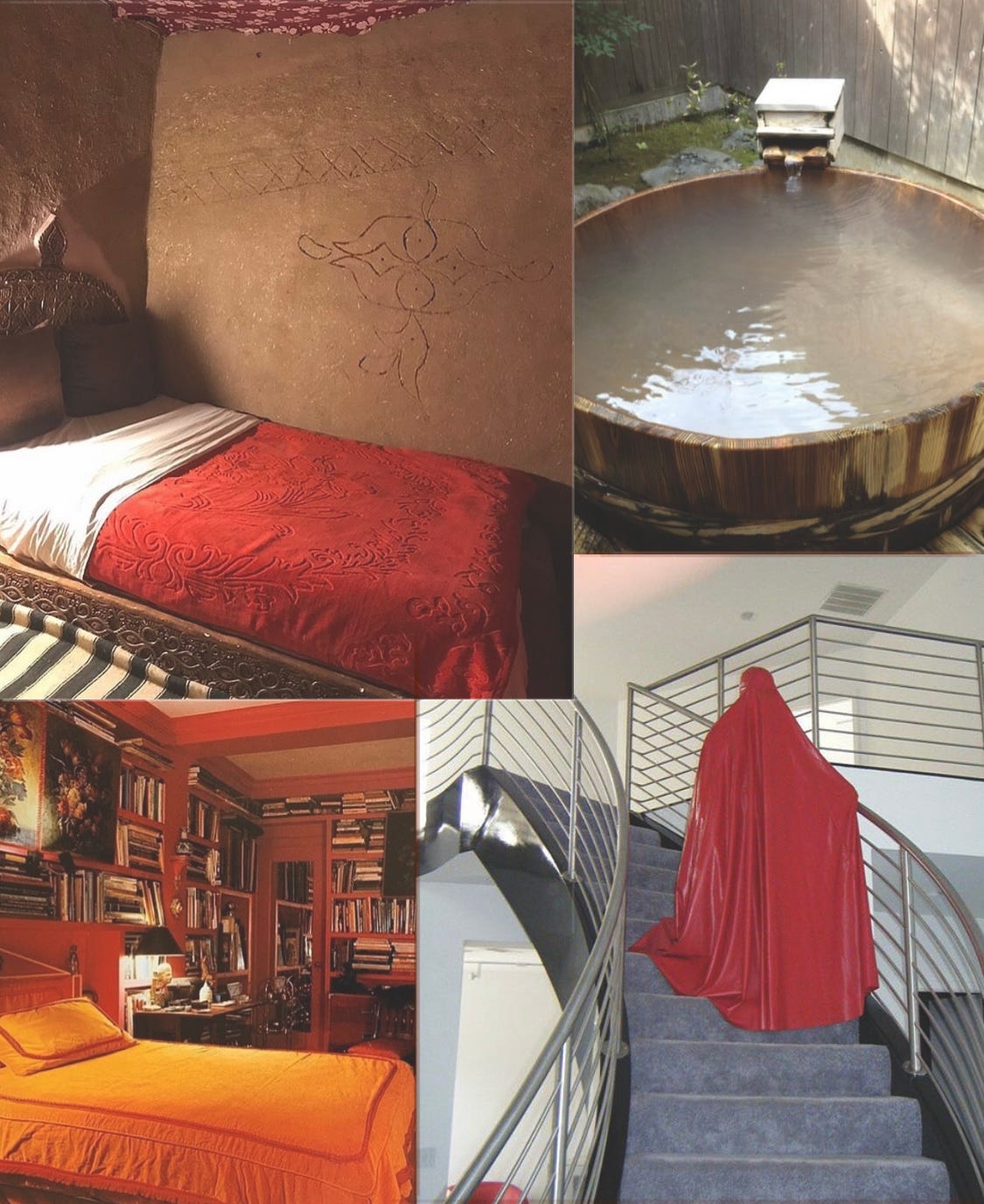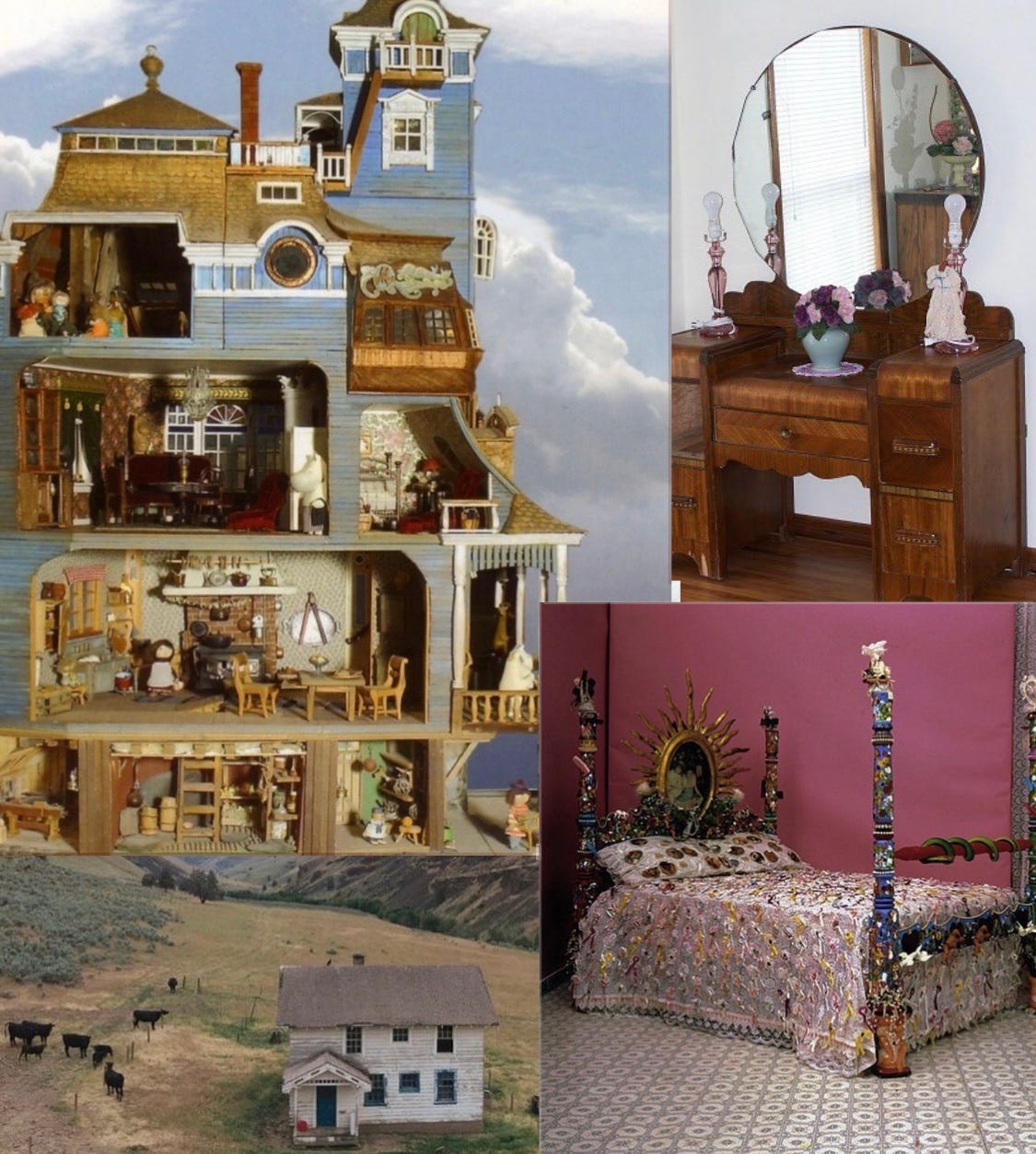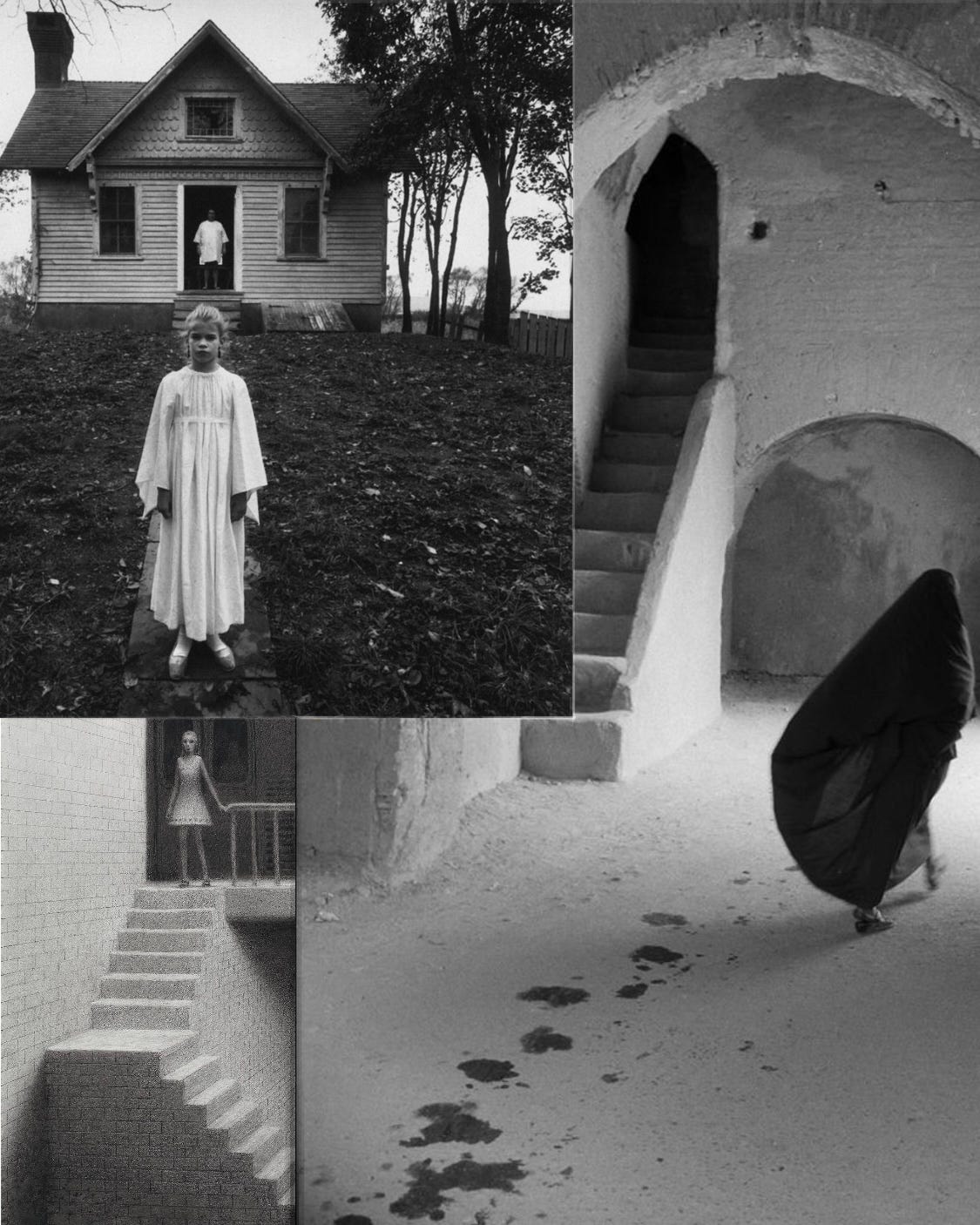In my dream I am in a house I do not know. The dream insists that it is mine, except I do not recognize its extra doors and the glassy ceiling that opens up to the sky. I climb a narrow staircase to a room emitting orange and red hues positioned warmly at the end of the hallway. The dream tells me it is my bedroom. There I get the sense I am being watched from above through the dark and guiding ceiling-sky. I do not mind the feeling. A primal intimacy surges into my limbs from an unknown source situated deep inside the house and I decide to linger longer, now fully merged with the world of my dream. Suddenly I am overcome with the urge to draw a hot bath but I find the stairs have gone. I am told they were absorbed back into the unending dream skies and not to worry. In step with the dream, I gradually drift downward, hovering at each level, searching for an alternative route to the sacred wellspring I now seek.. I have always sought, I realize, and finally, I am rooted in the foundation of the house. Revealed to me is an ancient pool made of stone tile where I swim in seemingly holy waters until I wake.
Sometimes I am bit by a snake at the bank where the pool becomes a river. Sometimes I am met with a friend who is faceless to learn secrets I won’t remember come morning. Sometimes I curl up into a fetal position and weep, letting the soft waves the moon makes wash over me. And sometimes I fall to my knees and begin to pray.
There was a time in my life coinciding with the inception of my archival page, ‘girlm0ss’, where I dreamed different versions of this dream almost every night for weeks. The visions plagued me as I obsessively searched for answers about what it all meant. Turns out I am not the lonely dreamer I thought I was. The house is one of the most common dream symbols according to Swiss psychiatrist Carl Jung. In fact, it has become customary to introduce 'Jung' with his very own famous house dream…So, let us dive back into the dream world for a moment.
I was in a house I did not know, which had two storeys. It was "my house". I found myself in the upper storey, where there was a kind of salon furnished with fine old pieces in Rococo style. On the walls hung a number of precious old paintings. I wondered that this should be my house and thought "not bad". But then it occurred to me that I did not know what the lower floor looked like. Descending the stairs, I reached the ground floor. There everything was much older. I realized that this part of the house must date from about the fifteenth or sixteenth century. The furnishings were medieval, the floors were of red brick. Everywhere it was rather dark. I went from one room to another thinking "now I really must explore the whole house." I came upon a heavy door and opened it. Beyond it, I discovered a stone stairway that led down into a cellar. Descending again, I found myself in a beautifully vaulted room which looked exceedingly ancient. Examining the walls, I discovered layers of brick among the ordinary stone blocks, and chips of brick in the mortar. As soon as I saw this, I knew that the walls dated from Roman times. My interest by now was intense. I looked more closely at the floor. It was of stone slabs and in one of these I discovered a ring. When I pulled it, the stone slab lifted and again I saw a stairway of narrow stone steps leading down to the depths. These, too, I descended and entered a low cave cut into rock. Thick dust lay on the floor and in the dust were scattered bones and broken pottery, like remains of a primitive culture. I discovered two human skulls, obviously very old, and half disintegrated. Then I awoke.
Jung had this dream in 1909 while on a voyage to America with Freud. He decided that the dream house was an architectural model of the individual psyche, each floor symbolizing different levels of human consciousness. The first floor represents our normal, waking consciousness and the caverns represent our most primitive unconscious mind and so on. The analysis of this particular dream led him to produce his idea of the “collective unconscious” – a universal cache of inherited ancestral memories and archetypes.
Jung regarded his theory of the collective unconscious as his greatest achievement. In short, it states that some contents of our unconscious mind originate
“[Not in personal experience] but in the inherited possibility of psychic functioning in general, i.e., in the inherited structure of the brain. These are the mythological associations, the motifs and images that can spring up anew anytime anywhere, independently of historical tradition or migration. I call these contents the collective unconscious.” (Jung, 1921/1973, par. 842)
His theory gave me answers as to why, much like some dreams, certain images trigger an unexplainable visceral response deep within my being. Coming to this realization, I felt an intense need to mediate my dreams, physical feeling, and emotions through images, symbols and archetypes. I began collecting images and sharing them on a whim as a creative outlet in my free time. My thoughts soon became more organized and I felt like a whole new me, more attune to myself and my environment. The inexplicable pull towards this endeavor started making more sense when I stumbled upon this fascinating article by Frederika Tevebring about the life and work of Jung’s friend and Swiss archivist, Olga Fröbe-Kapteyn. The excerpt below from “Images from the Collective Unconscious: Olga Fröbe-Kapteyn and the Eranos Archive,” introduces us to Fröbe:
“In the 1930s, Olga Fröbe-Kapteyn (1881–1962), artist, mystic, and founder of the multidisciplinary forum Eranos, began assembling an extensive archive of images. Its purpose was to offer a “respite from logical thinking in words and concepts”, relying instead on the “magic wand of analogy”. The archival project was grounded in Carl Gustav Jung’s notion of the collective unconscious, which he considered to be a universal part of the human mind, holding memories inherited from our ancestors. Accordingly, Fröbe saw her collection’s images as archetypes — memories from the deep religious and symbolic past as they manifested across different cultures and epochs.”
Fröbe’s goal was for the image archive to grow into an institution and become a tool for research and instruction in the unraveling of dream archetypes. It would give dreamers the means to cross-reference their visions with all of human culture throughout history and today. Archive visitors could access various dream "departments" sorted by pictures (mainly archaeological and ethnographic) and texts (ranging from Christian mystics to alchemic treatises and Eastern and Western yoga and meditation systems). Her project inspired thinkers such as the myth theorist Joseph Campbell and the psychoanalyst Erich Neumann, who based his book The Great Mother (1955) on the image collection.
Discovering Olga Fröbe-Kapteyn’s story provided solace to my reservations about sharing things online. Her personal journey of self-discovery resonated deeply with my own. Her project, which she said was “born in the darkest hour of European chaos [WWII],” mirrored my own confrontation with the post-p*ndemic world, a time of upheaval that has left many souls awakened and forever transformed. By exploring these concepts, I attempt to establish a foundation for the perspective of my online projects, using both images and text to weave stories and make sense of the universal human experience. Let this newsletter serve as a humble reminder that stories help us relate to each other and make creative expression possible. So tell me, dear reader, do you also dream of mysterious houses?









This is such a foundational metaphor for living, isn’t it? Beautiful topic. When I have dreamed of navigating the architecture of a home I’m usually in full on exploration mode. It seems to be spirit houses I’ve never seen before but that I have built within my subconscious mind with little secret doors and passageways. It feels like a relief to be there moving forward and never back. However, I do have reoccurring dreams of visiting my childhood home and it looks the exact same. In my experience, I’m collecting pieces of the past that I dropped off. To me it’s apart of soul retrieval to go back to old haunts. It is highly nostalgic. Can’t wait to read part II ♾️
So interesting and wonderfully illustrated! Don’t miss the Archive for Research in Archetypal Symbolism, another temple for images: aras.org
Yes, dream houses and other such constructions. I believe many of us are architects in the imaginal realms and why not? Who knows what is the significance or import of our weaving on the other side of the tapestry?
Thanks for bringing your beauty into being!